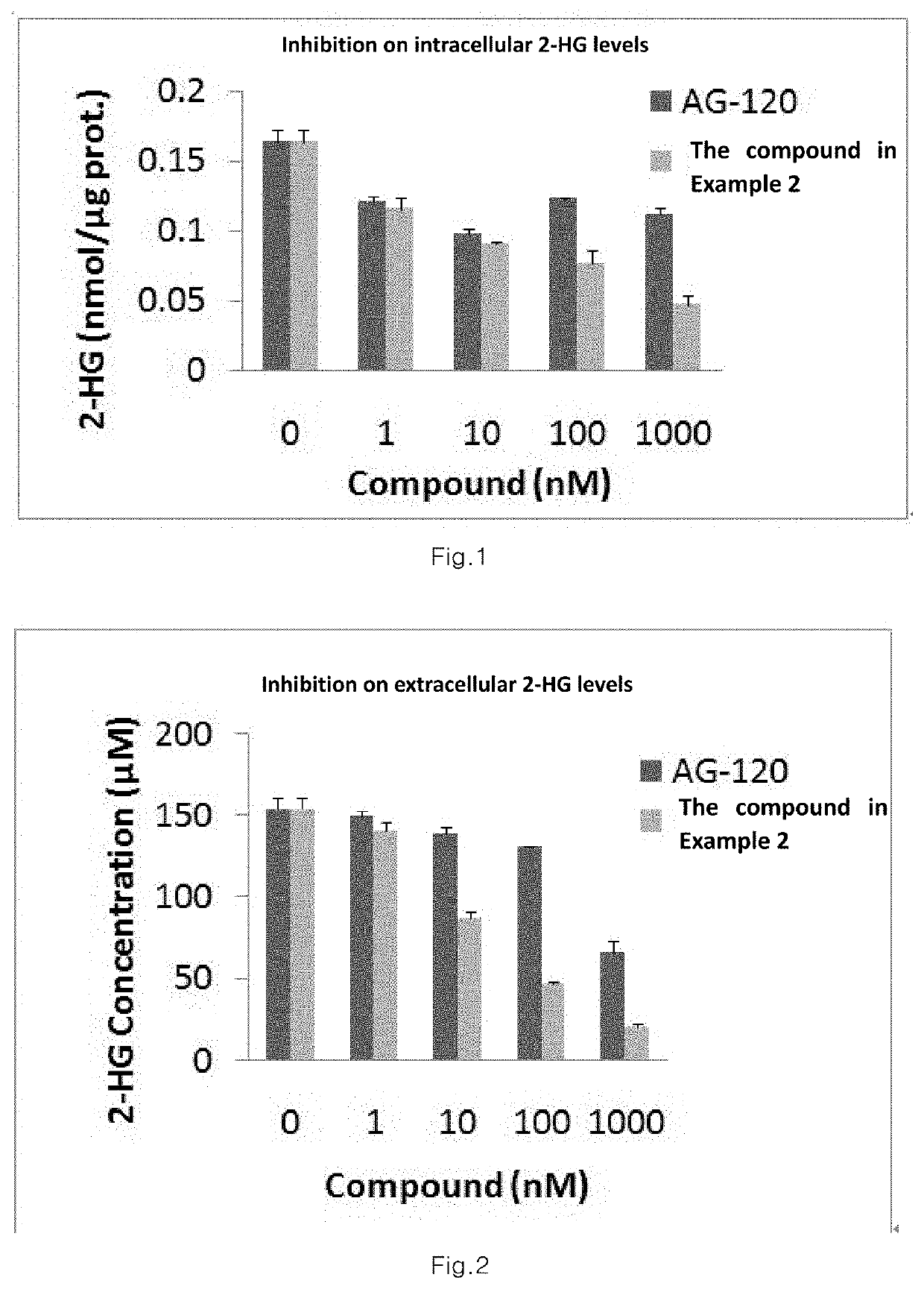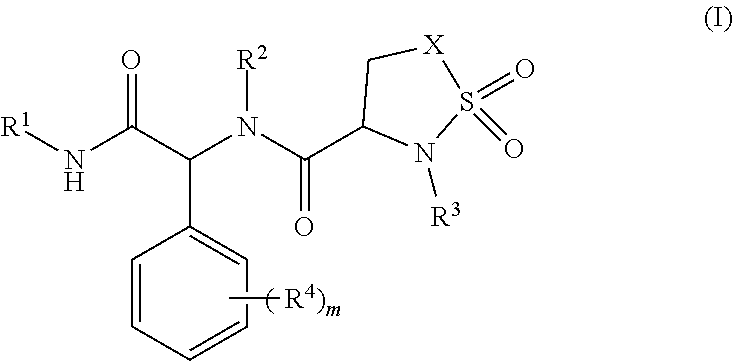Sultam Compound And Application Method Thereof
a technology of sultam and compound, applied in the field of sultam compound for cancer treatment, can solve the problems of hypermethylation of chromatin, excessive proliferation, and reduced activity of -kg-dependent enzymes
- Summary
- Abstract
- Description
- Claims
- Application Information
AI Technical Summary
Benefits of technology
Problems solved by technology
Method used
Image
Examples
example 1
)-1-(2-chlorophenyl)-2-((3,3-difluorocyclobutyl)amino)-2-oxoethyl)-2-(4-cyanopyridin-2-yl)-N-(5-fluoropyridin-3-yl)-isothiazolidine-3-carboxamide 1,1-dioxide
[0170]
Step A: dimethyl L-homocysteinate Dihydrochloride
[0171]
[0172]Under stirring in an ice bath, thionyl chloride (10.64 g, 89.4 mmol) was added dropwise into a suspension of L-homocysteine (8.0 g, 29.8 mmol) in methanol. The solution is gradually clear. After the addition was completed, the reaction solution was stirred for 10 min, followed by removing the ice bath, and stirred again at room temperature overnight. The solvent was removed, so as to give dimethyl L-homocysteinate dihydrochloride (10.6 g, yield 100%).
[0173]1H-NMR (400 MHz, DMSO-d6): δ=8.79 (s, 6H), 3.75 (s, 6H), 2.95-2.80 (m, 4H), 2.52-2.47 (m, 2H), 2.20-2.10 (m, 4H).
Step B: methyl (S)-2-amino-4-chlorosulfonylbutyrate Hydrochloride
[0174]
[0175]Under stirring in an ice bath, chlorine gas was introduced into a mixed solution of dimethyl L-homocysteinate dihydrochlor...
example 2
)-1-(2-chlorophenyl)-2-((3,3-difluorocyclobutyl)amino)-2-oxoethyl)-2-(4-cyanopyridin-2-yl)-N-(5-fluoropyridin-3-yl)-isothiazolidine-3-carboxamide 1,1-dioxide
[0191]
[0192]In Step F of Example 1, (S)—N—((S)-1-(2-chlorophenyl)-2-((3,3-difluorocyclobutyl)amino)-2-oxoethyl)-2-(4-cyanopyridin-2-yl)-N-(5-fluoropyridin-3-yl)-isothiazolidine-3-carboxamide 1,1-dioxide was isolated by thin layer chromatography.
[0193]1H-NMR (400 MHz, CDCl3): δ=8.47 (d, J=5.1 Hz, 1H), 8.31 (s, 1H), 8.08 (d, J=8.1 Hz, 1H), 7.62 (s, 1H), 7.30-6.75 (m, 6H), 6.56 (s, 1H), 6.22 (s, 1H), 4.80-4.70 (m, 1H), 4.40-4.30 (m, 1H), 3.75-3.65 (m, 1H), 3.40-3.33 (m, 1H), 3.10-2.98 (m, 2H), 2.60-2.40 (m, 4H).
[0194]m / z=619 [M+H]+.
[0195]HPLC conditions: chiral column: CHIRALPAK®IC-3 column (25 cm); mobile phase: n-hexane / ethanol=85 / 15; flow rate: 0.8 mL / min; column temperature: 40° C.; wavelength / time: 210 nm, 20 min; retention time: that of the title compound in Example 2 is 17.91 min.
example 3
)-1-(2-chlorophenyl)-2-((3,3-difluorocyclobutyl)amino)-2-oxoethyl)-2-(4-cyanopyridin-2-yl)-N-(3,5-difluorophenyl)-isothiazolidine-3-carboxamide 1,1-dioxide
[0196]
Step A: (3S)—N-(1-(2-chlorophenyl)-2-((3,3-difluorocyclobutyl)amino)-2-oxoethyl)-N-(3,5-difluorophenyl)-isothiazolidine-3-carboxamide 1,1-dioxide
[0197]
[0198]Referring to Step E in Example 1, the reaction material 3-amino-5-fluoropyridine was replaced with 3,5-difluoroaniline to give the desired product of (3S)—N-(1-(2-chlorophenyl)-2-((3,3-difluorocyclobutyl)amino)-2-oxoethyl)-N-(3,5-difluorophenyl)-isothiazolidine-3-carboxamide 1,1-dioxide (yield 13%).
[0199]m / z=619 [M+H]+.
Step B: (S)—N—((R)-1-(2-chlorophenyl)-2-((3,3-difluorocyclobutyl)amino)-2-oxoethyl)-2-(4-cyanopyridin-2-yl)-N-(3,5-difluorophenyl)-isothiazolidine-3-carboxamide 1,1-dioxide
[0200]
[0201]Referring to Step F in Example 1, (S)—N—((R)-1-(2-chlorophenyl)-2-((3,3-difluorocyclobutyl)amino)-2-oxoethyl)-2-(4-cyanopyridin-2-yl)-N-(3,5-difluorophenyl)-isothiazolidine-3...
PUM
| Property | Measurement | Unit |
|---|---|---|
| Capacitance | aaaaa | aaaaa |
| Capacitance | aaaaa | aaaaa |
| Molar density | aaaaa | aaaaa |
Abstract
Description
Claims
Application Information
 Login to View More
Login to View More - R&D
- Intellectual Property
- Life Sciences
- Materials
- Tech Scout
- Unparalleled Data Quality
- Higher Quality Content
- 60% Fewer Hallucinations
Browse by: Latest US Patents, China's latest patents, Technical Efficacy Thesaurus, Application Domain, Technology Topic, Popular Technical Reports.
© 2025 PatSnap. All rights reserved.Legal|Privacy policy|Modern Slavery Act Transparency Statement|Sitemap|About US| Contact US: help@patsnap.com



